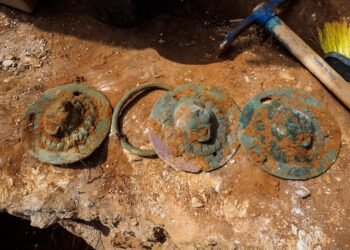In the recent excavation campaign at the La Draga Neolithic settlement in Banyoles, Catalonia, researchers have unearthed wooden architectural elements that provide profound insights into the construction techniques and daily lives of its ancient inhabitants.

La Draga, first discovered in 1990, is one of the oldest known farmer and herder settlements in the northeast of the Iberian Peninsula and one of the earliest Neolithic lake settlements in Europe, dating back to 5200-4800 BCE.
During the June excavation, archaeologists uncovered large wooden planks and structural elements that are believed to correspond to the walls and floors of Neolithic huts. These elements, made primarily of oak, yew, and boxwood, were found in an exceptionally well-preserved state due to the anaerobic conditions of the soil at the water table level in sector B of the site. This preservation has allowed for detailed study of the materials, which are currently being analyzed by experts.
The discoveries include not only structural components but also several domestic objects and tools. Among the items recovered were handles, a beater, a whisk, and a fragment of a basket, all made from a variety of woods. The use of different types of wood for specific tools suggests that the Neolithic inhabitants had sophisticated knowledge of material properties and employed them accordingly.
According to the researchers: “Sector B has provided exceptional preservation of the wooden elements. This conservation allows a detailed study of the materials, which are currently being analyzed by experts.”
The La Draga project is a collaborative effort involving the Autonomous University of Barcelona (UAB), the Spanish National Research Council (CSIC-IMF Barcelona), the Museum of Archaeology of Catalonia (MAC), and the Underwater Archaeology Center of Catalonia (CASC). Additionally, members of the Archaeobotany Unit of the Catalan Institute of Human Paleoecology and Social Evolution (IPHES-CERCA) have actively participated in the research. Notable contributors include Blanca Garay, a predoctoral researcher at IPHES-CERCA, and Dr. Marian Berihuete, a researcher at UAB and an associate researcher at IPHES-CERCA.
This year’s excavation campaign also involved undergraduate students in Archaeology from the Autonomous University of Barcelona and master’s students in Nautical and Underwater Archaeology from the University of Cádiz. Over the course of three weeks, intensive work was carried out in the terrestrial sector of La Draga, particularly focusing on sector B.
The ongoing research at La Draga is part of a four-year project in archaeology and paleontology, spanning from 2022 to 2025, and coordinated by the Regional Archaeological Museum of Banyoles. The project is funded by various institutions, including the Ministry of Science, Innovation and Universities.
Catalan Institute of Human Paleoecology and Social Evolution
























